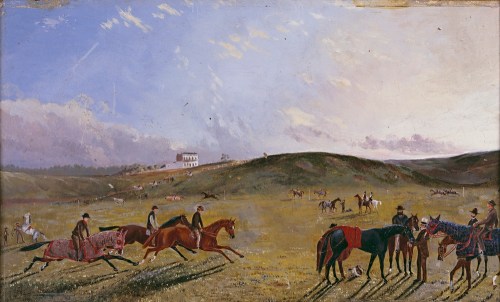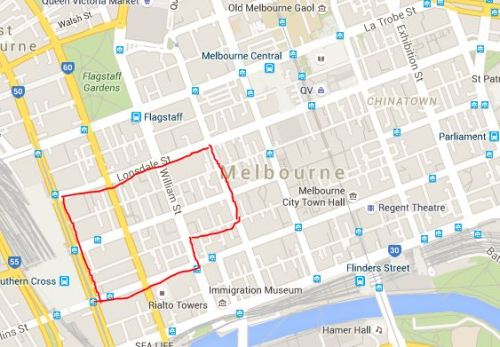OFF TO THE RACES
While the serious work of opening the Supreme Court was under way, there was another more lighthearted occasion unfolding during the post-Easter week in Port Phillip: the District Races! The three-day racing carnival, held under the auspices of the Port Phillip Turf Club was held on 13th, 14th and 15th April “on the same course as last year”, ie. along the banks of the Maribyrnong River in what would come to be known as Flemington. This was the fourth time the autumn races had been run, after initially being conducted on the swampy ground at the base of Batman’s hill in what is now Southern Cross Railway station. In 1840 ‘The Melbourne Racecourse’ shifted to what would become Flemington, which continues as a racecourse to this day.

Flemington Race Course 1867 Artist: Thomas Hamilton Lyttleton. (Note that this painting depicts the raceourse 25 years on). Source: State Library of Victoria [http://slv.vic.gov.au]
The Melbourne newspapers (and most especially The Port Phillip Herald) and that wellspring of all things Port Phillipian, The Chronicles of Early Melbourne (available online here) by ‘Garryowen’ devoted many paragraphs to the races. We tend to forget that until about 20 years ago television newscasts did too, before yielding the racing time-spot to financial news instead when we all found ourselves to be investors instead (another form of punting, perhaps?) I won’t bore you with the details of the race, but the report of the weather on the first day is rather poetic:
Day broke on Tuesday, the Fourth Anniversary of the Melbourne Races in a remarkably ‘skittish’ humour, a strong north-wester scoured the streets at a ‘hard gallop’ while a heavy fall of rain completed the unpromising aspect. As the day advanced, Sol drew his curtains, and plucking off his night cap, inbued himself in his most gorgeous robes, and mounting his car, smiled propitiously as he touched up his steads. This change of affairs caused sundry of the good folks of Melbourne to rub their hands, look very knowing, and giving their collars the extreme altitude, sagely remark there was a prospect of a very fine day’. PPH 16 April 1841
It seems that a good day was held by all, particularly on the more numerous attended first Tuesday of the racing carnival:
The course exhibited a gay appearance from the numerous pennants fluttering from the booths lining one side of the course, while cheering strains poured forth at intervals from two band, one at the grand stand, and the other in the William Tell booth, all of these receptacles of good cheer contained the usual quantum of viands and fluids, the latter of which must have been poured forth copiously, judging from events towards the end of the day. (ibid)
Well, yes. Obviously the ritual of finding oneself tired and emotional at the racetrack has a long history and this 1841 racing carnival was no exception. One of the Border Police became drunk and “drawing on his butchering knife, [cut] one person through the hat to the skull, until the blood flowed in torrents”. One unfortunate man was trampled and later died.
RETURN OF THE GIPPS’ LAND OVERLANDERS
You might remember that after the wreck of the Clonmel in January 1841, a number of men returned to Gipps’ Land to scope out the potential. In late March three of the men returned by sea, bringing early positive reports, leaving the others to return overland. The Port Phillip Herald of 16 April 1841 carries news of their return in a day-by-day description of their journey.
They started off on March 23rd , where they encountered a tree marked by Mr Macmillan in his expedition, before camping the night at a swamp in extremely barren land. On 24th they followed the treeline to a hill where they could see Wilson’s Promontory and a portion of 90 Mile Beach. On 25th they reached a peak from which they could see the fertile plains forming the interior of Gipps’ Land before travelling to the La Trobe River. They followed the La Trobe on 26th where they found yet another marked tree and a carved message “this is the Ross River, a north-east course will bring you to the plain”. From here they could see the peaks of the Snowy Mountains, before reaching the Maconochie River. On 28th (was 27th a day of rest?) they crossed the Maconochie and reached Count Strezlesci’s encampment on the Barney River, which they crossed, later arriving at the Dunlop river where they camped. On 29th they perceived Lake Wellington, a large inland lake which received the waters of the La Trobe, Maconochie, Barney, Dunlop and Perry Rivers. On the 30th they began their journey to Melbourne, tracing back and encountering the same rivers, encountering the Kirsopp River on 3rd, and finally arriving home in Melbourne on 13th April.
Their summary of what they found was:
The general character of the new country which the party explored is, that it is well watered, the banks of the rivers are lined with the finest of every description of timber, and the intermediate land either gently undulating or quite level plains of rich alluvial soil, supposed to be in consequence of the deposits of the numerous rivers from the ranges of the Snowy Mountains. Throughout the whole of Gipps’ Land scarcely a rock was visible.
THE ‘RULES’
One of the early tasks that Judge Willis undertook was defining the ‘rules of the debtors’ prison’. In a small town with severely limited prison facilities, it was not practical to lock up all debtors,and it became even less feasible as the District plunged into widespread insolvency over the next few months. Instead, people were ‘confined to the rules’ by being restricted to a defined part of town. They were not allowed to visit any hotels or houses of ill-repute that might be in that area. Willis defined the Rules as follows:
The rules of the debtors’ prison in Melbourne shall be comprised within the bounds following, that is to say, all that part of Collins’street which lies between Spencer-street and the north east side of William’s street, so much of William’s Street as lies between Collins Street and the north west side of Little Collins street, so much of Little Collins street as lies between Williams street and the north east side of Queen street, so much of Queen street as lies between Little Collins street and the north west side of Lonsdale street, so much of Lonsdale street as lies between Queen street and the south west side Spencer Street, and that part of Spencer street which lies between Lonsdale street and the south east side of Collins street, together with the area comprised within and bounded by the portions of streets aforesaid; and all the houses (except as hereafter is excepted) on each side thereof. Provided that all taverns, victualling houses, ale houses, or houses licensed to sell spirituous liquors, houses of public entertainment and also all disorderly houses, and houses of ill fame shall be excluded out of, and form no part of the said rules.- JOHN WALPOLE WILLIS, Resident Judge, March 31st 1841.
Here’s a rather wonky diagram drawn onto a present-day map:

Although today this area is dominated by offices, at the time most of the settlement was located in this area so it was not necessarily a hardship to be ‘confined to the rules’.
A CHILD ABUSE CASE
With our present-day attention drawn to the Royal Commission on Institutional Responses to child abuse, it is interesting and sad to read of a child abuse case in 1841. In this first week of Supreme Court hearings, Henry Watson was indicted for an assault with intent on seven-year old Imogene Liardet, the daughter of the publican and artist W.F.E. Liardet, whose illustration heads this blog.In hearing the case, Willis, like all other judges, had to determine the fitness of the child to take the oath, a decision based on the child’s understanding of God and truth. In this case, Willis decided that the case could not proceed. The papers reported the case delicately:
There can be little doubt but for the tender age of the child, who could not understand the nature of the offence brought forward, that the charge would have been brought home to the miscreant, and that an exemplary punishment would have followed. His Honor himself felt morally certain of the fellow’s guilt. We cannot pollute our columns with details so disgusting. The prisoner was acquitted and discharged. (PPH 16 April)
Judge Willis’ casebooks, available at the RHSV Judge Willis site, give more information. http://www.historyvictoria.org.au/willis/book%2011.html#4
Her description of the offence is poignant in her innocent retelling:
The Pris’r took me into the Stable after the time of the Regatta & pulled up my Petticoats, put his in mine – his – Cockadoodle – he lay on my person – he was long on me ab’t half an hour – after that he took me out of the Stable I told Mama wh’t had happened – When I went out I told Mama directly –
On 30th April the Port Phillip Herald reported that Henry Watson was captured again “endeavouring to commit a similar assault on a woman at the wharf”.
EARTH-SHAKING NEWS!
Quite literally. An earthquake was reported at about 3.00 a.m. on 21 April. It’s an interesting thought that in these early years of white settlement, people wouldn’t really know what could be expected in terms of earthquakes, floods, droughts etc.
AND SPEAKING OF THE WEATHER…
During the week there was a light wind, freshening at times with generally dull weather and occasional rain. The top temperature for the week was 74degrees (23.3C)
Other references:
Lemon, Andrew ‘Inventing the Melbourne Cup’ La Trobe Journal 88, Dec 2011
Macdonald, Judy, ‘James Watson and ‘Flemington’: a Gentleman’s Estate’, pp.1-25. Latrobeana Vol 8, No 3 November 2009

LOL having just read Xavier Herbert’s description of a race meeting in Poor Fellow My Country, I suspect I have a more realistic view of events than the Melbourne newspapers chose to record!
Love the weather report “As the day advanced, Sol drew his curtains…”. The clowns the tv stations use now should study the Port Phillip Herald.
Googled Strezlecki, it seems he went through Gippsland, coming south from Mt Kosciusko, only 11 months before the Clonmel party, but was he the explorer who left the marked trees?
There are some constants about horse racing and being tired and emotional seems to be one of them. I note you employ the same google cartographer as myself but it seems he or she becomes tired and emotional too. It is odd that it is so hard to draw a straight line on a map. We need to practice.
LOL. You’re not wrong. And this was about my third attempt at it!
Pingback: This Week in Port Phillip 1841: 23 -30 April 1841 | The Resident Judge of Port Phillip